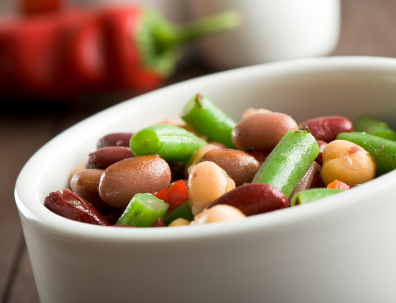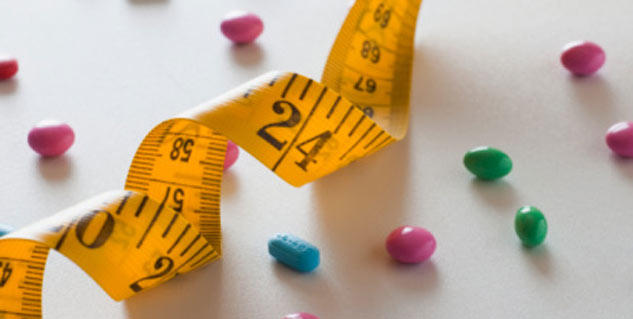Spilling the Beans on Bean Benefits
While fruit, vegetables and whole-grains are well-known sources of fiber, many people are still unaware that beans are one of the best sources of hunger-squelching fiber. Fiber has been shown to increase satiety and slow the rate at which foods pass through your digestive tract. Some studies have demonstrated that large intakes of fiber can help regulate blood glucose and insulin levels, thereby keeping your appetite in check. In addition to being full of fiber, beans also provide protein, iron, folate, and some minerals.
Not only are beans a nutrition powerhouse, they are also easy to prepare, whether you choose dried, canned, or frozen. Beans are also very cheap, especially when compared to other protein-rich foods such as meats, seafood, poultry, and dairy products - all of which can put quite a dent in your wallet. Beans can easily be used in place of meats in most recipes.
 Unsure about how to incorporate more beans into your diet? It's best to start off slowly. There are many types of beans, each with a different texture and flavor. Experiment with using different types of beans in your recipes to find which ones you like the most. Try adding beans to foods that you already enjoy. Add beans to your favorite soup, or top your salad with a quarter cup of your favorite beans. Stretch your meat dishes by substituting half of the ground meat called for in a recipe for mashed kidney beans (if you do this, you'll up the fiber content while slashing the fat). Add beans to your salsa, or puree beans with a little olive oil in a blender or food processor, and use this as a sandwich spread or dip for fresh vegetables.
Unsure about how to incorporate more beans into your diet? It's best to start off slowly. There are many types of beans, each with a different texture and flavor. Experiment with using different types of beans in your recipes to find which ones you like the most. Try adding beans to foods that you already enjoy. Add beans to your favorite soup, or top your salad with a quarter cup of your favorite beans. Stretch your meat dishes by substituting half of the ground meat called for in a recipe for mashed kidney beans (if you do this, you'll up the fiber content while slashing the fat). Add beans to your salsa, or puree beans with a little olive oil in a blender or food processor, and use this as a sandwich spread or dip for fresh vegetables.To minimize some of the unpleasant side effects beans can cause, be sure to rinse canned beans well before incorporating them into your dishes. Rinsing beans will help eliminate the gas-producing compounds as well as nearly half of the sodium.
A word of caution: You need to gradually increase your fiber intake. Adding too much fiber too quickly can cause some gastrointestinal distress. It will take your body some time to adjust to higher intakes of dietary fiber. Also, be sure to drink extra fluids as you increase your fiber intake to prevent constipation.
Kari Hartel, RD, LD is a Registered Dietitian and freelance writer based out of St. Louis, MO. Kari is passionate about nutrition education and the prevention of chronic disease through a healthy diet and active lifestyle. Kari holds a Bachelor of Science in Dietetics from Southeast Missouri State University and is committed to helping people lead healthy lives. She completed a yearlong dietetic internship at OSF St. Francis Medical Center in Peoria, IL, where she worked with a multitude of clients and patients with complicated diagnoses. She planned, marketed, and implemented nutrition education programs and cooking demonstrations for the general public as well as for special populations, including patients with cancer, heart disease, diabetes, Alzheimer's disease, obesity, and school-aged children. Contact Kari at [email protected].
-
How To Properly Exercise After Forty
Studies have shown that if you start a physical fitness program after
-
Feeling Weighed Down? Use These Tips To Lose It!
Fads abound for weight loss. To learn which ones are right for y
-
The Mediterranean Diet and Weight Loss
If youre looking for a way to lose weight and lower your risk of he
-
Low Carb Diets Revealed
With all of the conflicting studies and open interpretation of advice,
-
Getting Motivated to Loose Weight
by Robert Kaufman Losing weight is simple. The simple weight loss sec
-
10 Tips On How To Lose Weight And Boost Spirituality
In order to have optimum health most Ame
- DON'T MISS
- Two Fridges and a Deep-Freeze - Abundance or Scarcity?
- Easy Ways For You To Lose Weight
- Lose Weight With Long Distance Walking One Step At A Time
- The Truth Behind Low Calorie Diets
- Losing Unwanted Pounds When People Get Older
- Alzheimer’s disease prevention with coffee may be possible: Studies
- The Sensa Review You Are Looking For
- How to Identify Weight Loss Programs That Really Work
- The Secret Of Fad Diets
- Are unmet needs sending you to the refrigerator?




